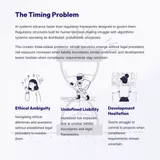Governance protocols for AI systems when regulation lags deployment
With AI regulation lagging, forward-thinking organizations can bridge the gap through robust internal governance frameworks, ensuring ethical AI development while gaining competitive advantage





